Yeovil Trades & Traders
Maynard & Son
Pastrycooks & Confectioners of the Borough
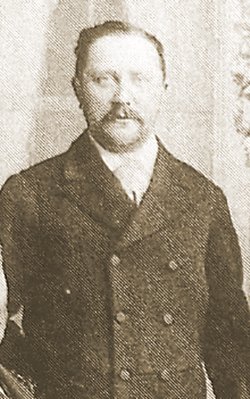 William
Laurence Maynard
was born on 20
January 1816 in
St George,
Hanover Square,
London. He was
the second son
of William
Maynard and Mary
née Lawrence. On
William Jnr's
marriage
certificate it
stated that his
father William
was a gentleman.
William
Laurence Maynard
was born on 20
January 1816 in
St George,
Hanover Square,
London. He was
the second son
of William
Maynard and Mary
née Lawrence. On
William Jnr's
marriage
certificate it
stated that his
father William
was a gentleman.
On 21 March 1844 William married Hannah Hawkins Way, daughter of William Way and Elizabeth née Hawkins, in the parish churches St George, Hanover Square. At the time of his marriage William was described as a baker in North Audley Street, Westminster.
By 1845 William and Hannah had moved to Yeovil where their daughter Elisabeth was born and in the 1851 census the family is shown living in Rotten Row (now Market Street).
William described his occupation as 'baker employing one man' and living with them were two of Hannah's sisters; Mary Bernard aged 29 an annuitant and Elizabeth Way aged 19 and a milliner. There was also one domestic servant. Despite being a baker, it appears from the poem reproduced below, that in 1858 William was producing the sausages for which he would gain some notoriety.
In 1861 the family was still living in Rotten Row but now in addition to daughter Elisabeth they had a son William aged eight and a daughter Lucy aged four. William described his occupation as 'baker employing one man 'and his employee, James Priddle an 18-year-old journeyman baker lived with the family, as did their house servant.
In the summer of 1862, Maynard succeeded to Rendall's "Old-Established Pastry and Confectionary Business" in Silver Street. The bakery business continued in Rotten Row - referred to in Maynard's advertisements of the time as Reckleford Street. The two premises were still being run throughout 1865 and 1866.
In February 1866, Hannam & Gillett sold off most of their ironmongery business to John Petter of Barnstaple, Devon, who gave it to his son James Bazeley Petter as a wedding present. At the same time John Perry, having been the manager of Hanham & Gillett's workshops for some 23 years, set up his own engineering business in South Street part of Hannam & Gillett's premises in partnership with his son.
In December 1866, William Maynard moved his established, family run business making pastries and confectionery and dealing in wines, to a new building in the Borough (technically High Street) close to the corner of Wine Street, as seen in the photograph below.
When the ancient building known as Under Bow was destroyed by fire and finally demolished in 1863, Maynard extended his premises by absorbing the site of the old building and creating one large, three-storey establishment that stretched from Wine Street to Tabernacle Lane. All the photographs below include the 1863-4 extension.
In the 1871 census William, Hannah and Elizabeth were listed at their address in the Borough. Also living with them was his aunt, a boarder, a live-in assistant in his shop and three domestic servants.
By the time of the 1881 census William was aged 65 and was living at his home in The Park with Hannah, daughter Lucy and a domestic servant. William described his occupation as confectioner and a note on the census form records that he was deaf.
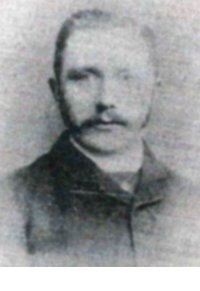 Also
by this time
his son, William
Tanner Maynard,
seen at left, was helping to
run the business.
William junior
was born in
Yeovil in 1853
and in the 1881
census the
28-year old
William
described his
occupation as
"Confectioner,
Sausage Maker
and Wine &
Spirit Merchant
employing 2 men
and 2 boys".
Living with him
on the premises
were his 23-year
old wife Emma
and their baby
daughter Hannah
who was less
than a month
old. Also living
there was
William's
sausage maker
uncle William
Way, a shop
assistant, a
young bake-house
boy, a nurse for
baby Hannah and
two general
domestic
servants. For a
whole generation
of Yeovilians
the junction of
Wine Street and
the Borough was
known as
Maynard's
Corner.
Also
by this time
his son, William
Tanner Maynard,
seen at left, was helping to
run the business.
William junior
was born in
Yeovil in 1853
and in the 1881
census the
28-year old
William
described his
occupation as
"Confectioner,
Sausage Maker
and Wine &
Spirit Merchant
employing 2 men
and 2 boys".
Living with him
on the premises
were his 23-year
old wife Emma
and their baby
daughter Hannah
who was less
than a month
old. Also living
there was
William's
sausage maker
uncle William
Way, a shop
assistant, a
young bake-house
boy, a nurse for
baby Hannah and
two general
domestic
servants. For a
whole generation
of Yeovilians
the junction of
Wine Street and
the Borough was
known as
Maynard's
Corner.
By the time of Queen Victoria’s Golden Jubilee in 1887 the business, now called Maynard & Son, was large enough to provide a celebratory lunch for the people of Yeovil.
William Laurence Maynard died in Yeovil on 28 July 1890 at his home in The Park. A brass, or bronze, tablet with ornate decoration of architectural arches and columns in black inlay, with lettering in black inlay with red inlay capital letters, 52cm wide x 53.5cm high, was originally affixed to the wall of the Baptist church in South Street. The inscription was as follows -
This tablet was
erected by his
children in
loving memory of
WILLIAM LAURENCE
MAYNARD
who died July
28th 1890 Aged
75 for
Eleven years he
held the office
of
Deacon in this
Church &
discharged its
duties with such
devotedness,
faithfulness
& generosity as
to secure the
confidence
and love of his
fellow members.
In the 1891 census William junior described his occupation as 'Confectioner & Wine Merchant (Master)'. He was living above the shop premises with Emma and four of their children, a confectioner's shopwoman, a cook and a nursemaid. The photograph above of William, a Deacon in the Baptist church in South Street, was taken in 1892.
|
In the 1891 edition of 'Where to Buy' Maynard & Son's business was given the following description -
Messrs.
Maynard
& Son Whoever has read the description given by Mr Vickery of the condition of the "Borough" in the past century, and compares it with the smart, beautifully kept High Street of to-day, cannot fail to appreciate the enterprise which has animated both the private citizens and the public authorities. In no part of the country will you find handsomer or better arranged shops; and among the most attractive of these, and one that strikes the eye at once on entering the centre of the "Borough" from Silver Street, Wine Street, or Middle Street, is the double-fronted Restaurant of Messrs Maynard and Son. This handsome shop is, in its internal arrangement, as attractive as it is externally, and is admirably adapted for the maintenance of a leading modern confectionery trade. The shop is neatly arranged, and contains a superior stock of cakes and general confectionery, while the spacious dining rooms are completely furnished throughout, and are shown off to additional advantage after nightfall by powerful electric light. The business has been established thirty years, and, for nearly a quarter of a century, has been in the hands of the present proprietors, and at the present time maintains a leading position. Messrs. Maynard and Son, by their enterprise, have established a large and valuable connection in Yeovil and the surrounding neighbourhood, their successful catering for balls, parties, dinners, and banquets being of a high standard of excellence. None but the purest ingredients are employed, and the staff of experienced pastry cooks enables the firm to turn out large quantities of high-class goods, and to undertake wedding, picnic, luncheon and similar orders on the shortest notice. The firm are agents for W & A Gilbey's wines and spirits, and for ales and stouts by Bass, Guinness, Allsopp, etc. The merits of the "Royal Yeovil" sausages, as supplied to Her Majesty the Queen, manufactured by Messrs. Maynard and Son, are yearly becoming more appreciated, and a very large quantity is now made to meet the demand.
The
firm,
about
twelve
months
since,
finding
the
adjoining
shop at
the
corner
of Wine
Street
was
becoming
vacant,
took it
over,
and
opened a
first-class
pork and
poultry
business,
where
excellent
pork and
sausages,
the best
fed hams
and
bacon,
and
poultry
in the
primest
condition,
are
supplied,
and this
subsidiary
business
has
developed
into a
valuable
adjunct
of the
Restaurant.
To both
branches
Messrs.
Maynard
and Son
give a
constant
personal
supervision,
and the
large
and
permanent
connection
they
have
secured
among
the
gentry
and
principal
inhabitants,
is the
best
testimony
to the
superior
manner
in which
the
business
has been
conducted. |
 In the
1901 census
William junior
was listed as
living at the
business
premises at 14
High Street with
his wife Emma,
daughters Hannah
and Edith and
son Leonard.
Also living on
the premises
were two lady
assistants in
the shop, a cook
and a housemaid.
The
advertisement
illustrated
below from
Whitby's Yeovil
Almanack
Advertiser of
1897 shows that
by this time the pastrycook and
confectionery
side of the
business had
been
supplemented by
meats and
Maynard was
advertising the
business as pork
butchers,
poulterers, ham
and bacon
curers. They
were also proud
that their
"Prize Medal
Royal Yeovil
Sausages" were
enjoyed by Queen
Victoria!
In the
1901 census
William junior
was listed as
living at the
business
premises at 14
High Street with
his wife Emma,
daughters Hannah
and Edith and
son Leonard.
Also living on
the premises
were two lady
assistants in
the shop, a cook
and a housemaid.
The
advertisement
illustrated
below from
Whitby's Yeovil
Almanack
Advertiser of
1897 shows that
by this time the pastrycook and
confectionery
side of the
business had
been
supplemented by
meats and
Maynard was
advertising the
business as pork
butchers,
poulterers, ham
and bacon
curers. They
were also proud
that their
"Prize Medal
Royal Yeovil
Sausages" were
enjoyed by Queen
Victoria!
In 1904 Maynard, described as a caterer, made an indemnity to the Great Western Railway for an agreement for rebuilding two rooms used as receiving office. He was presumably catering at railway stations as well. It was around this time that the upper floor of the Borough premises was converted to become the Boro' Restaurant.
In the early 1930's the business was bought by Cadena Café Ltd who advertised it as "Yeovil's largest and nicest cafe". It certainly was and I remember having lunch in the upstairs dining rooms most Saturdays during the later 1970's. The other things that many older Yeovilians will remember was the cashier half-way up the grand staircase and, whether they were patrons or not, the fabulous smell of roasting coffee that was fan-assisted into the Borough from the Cadena.
The Cadena Café closed in 1982 and the building was demolished in 1983 (see photos below), with the present building taking its place.
gallery
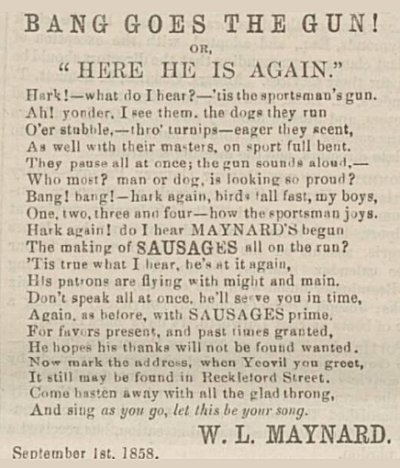
A poem used to advertise William Maynard's sausages from the 7 September 1858 edition of the Western Daily Press. Note that at this time Reckleford Street was the name of today's Market Street and was also known as Rotten Row. Maynard frequently used doggerel such as this in his advertisements.
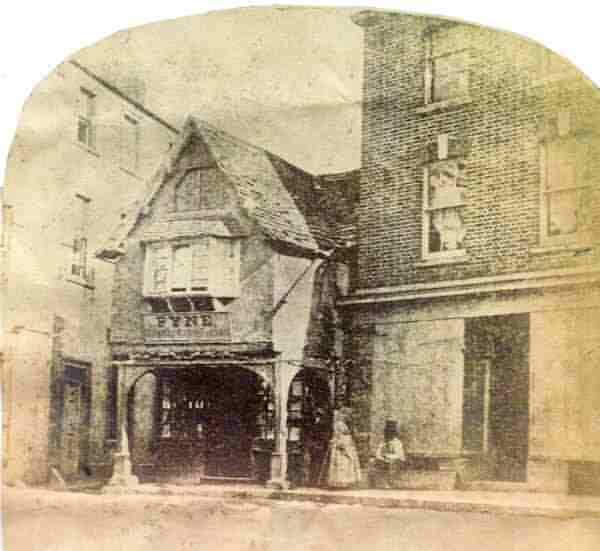
Courtesy of Mrs
M J Rogers
Under Bow, in the Borough on the corner of Grope Lane, photographed in 1861 by artist and photographer Frederick Treble. At far left is probably the first photograph of the Wine Street elevation of the newly-built Medical Hall, and at the right is an early photograph of the building that was part of Josiah Hannam's ironmongery and, later, William Maynard's Boro' Restaurant.

This advertisement was placed in the 21 December 1866 edition of the Western Gazette, when Maynard moved from his Silver Street and Rotten Row premises to the Borough premises.
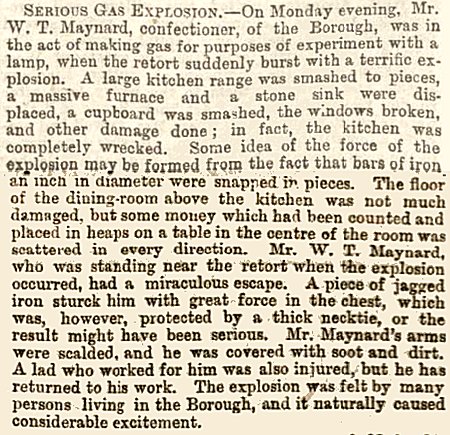
A report, from the Western Gazette's edition of 1 October 1880, of an explosion from which, it seems, WT was lucky to escape with relatively minor injuries.
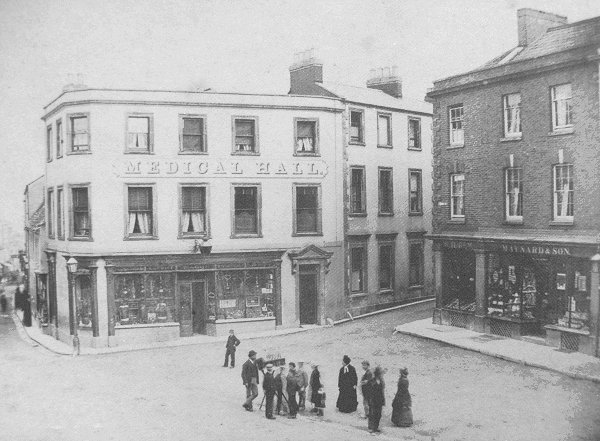
This photograph was taken in the 1890's and shows the old Medical Hall at left which was bombed in the Second World War. Right of centre is the entrance to Wine Street and at extreme right is William Maynard's shop in the Borough. Before Maynard's premises were built the site was occupied by a medieval building known as The Bow.
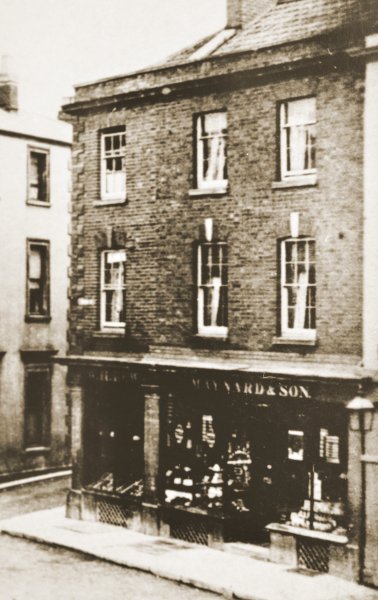
Maynard & Son's establishment, photographed in the 1890s.
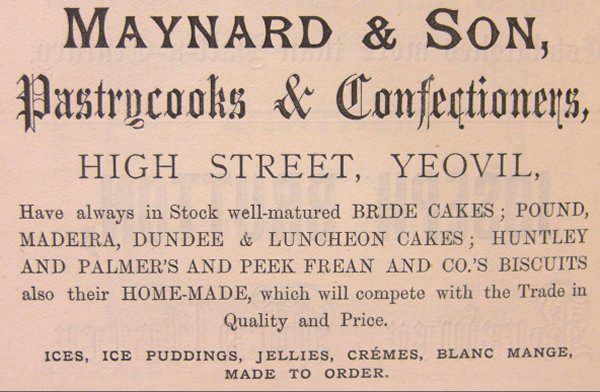
A Maynard & Son advertisement from Whitby's Yeovil Almanack Advertiser of 1882. I'm not sure if 'well-matured bride cakes' applied to the bride or the cakes!
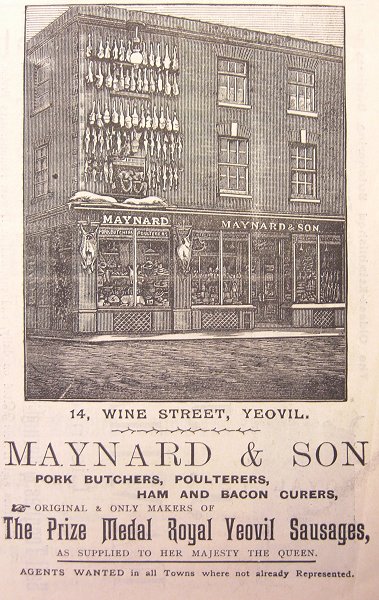
A Maynard & Son advertisement from Whitby's Yeovil Almanack Advertiser of 1897. By this time the pastrycook and confectionery side of the business had been supplemented by meats, presumably in that part of the shop on the corner of Wine Street festooned with dead poultry!
It's nice to see that Queen Victoria enjoyed "Prize Medal Royal Yeovil Sausages".
.... and did you spot the error on the advert? The business was at 14 High Street, not 14 Wine Street (which was past the Wine Vaults - don't make the same mistake as in the book "Then & Now, Yeovil" in which it is claimed there were two shops!).
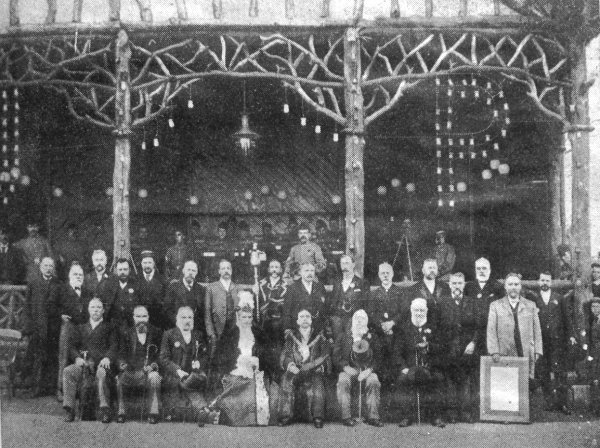
Courtesy of
Olly Ewens
This photograph is from a 1952 newspaper article and was taken on the occasion of the opening of Sidney Gardens in June 1898. The group, photographed with the Mayor, Mr John Vincent, has as its background the thatched bandstand given by Mr James Bazeley Petter to mark the opening. Standing (left to right) are: - E Benson, W Summers, J Kerby Whitby, Mr Brown, William Maynard, GH Gould, Edward Samuel Ewens, Henry Jesty (mace-bearer), William W Johnson, Charles J Hook, John Bazeley Petter (donor), W Armitage (Borough Surveyor), John Howe Farley, Walter J Nosworthy, William Beale Collins, Charles Fox. Sitting - Levi Beer, CW Pittard, Sidney Watts, Mrs Vincent, John Vincent (Mayor), Joseph Chaffey Moore, William Cox.
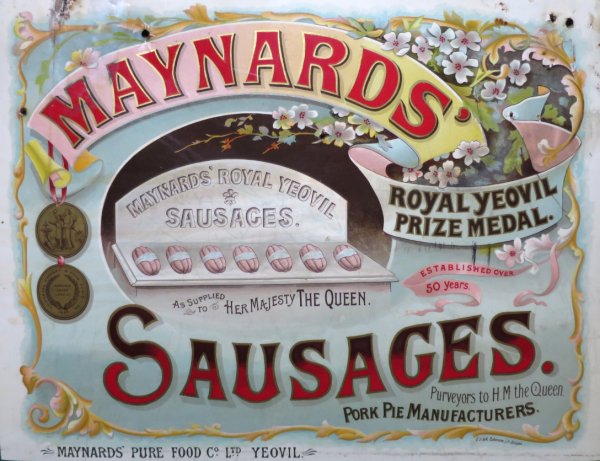
Courtesy of
Simon Laney
A gelatin-covered paper showcard for Maynards' "Royal Yeovil Prize Medal Sausages". Since it claims the business to be "Established over 50 Years", the date would be around the 1890s. It measures 24.5" x 20" (625mm x 510mm) - the damaged edges have been cropped in this photograph, but the image remains complete.
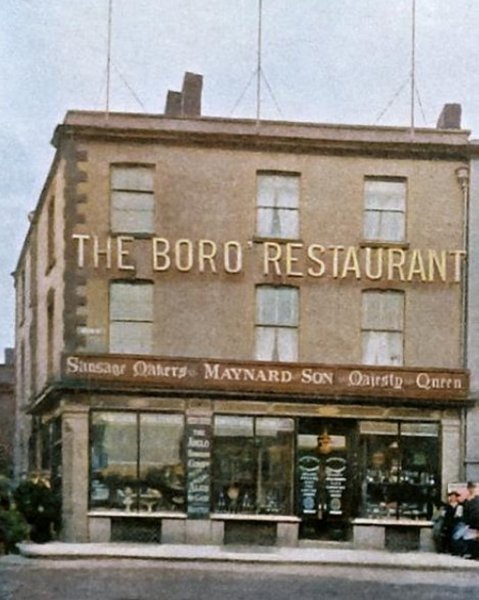
This colourised photograph was taken by Yeovil Photographer Jarratt Beckett and published in his 1897 book "Somerset viewed through a Camera". Maynard & Son proudly proclaims in their shop signage that they are "Sausage Makers to Her Majesty the Queen".

The decorations for the coronation of King Edward VII and Queen Alexandra in 1902.

This colourised photograph dates to about 1907, by which time Maynard had relinquished that part of his shop adjoining Wine Street. It was now occupied by Edwin Seddon, jeweller and watchmaker who installed the clock in the Western Gazette offices in 1906.
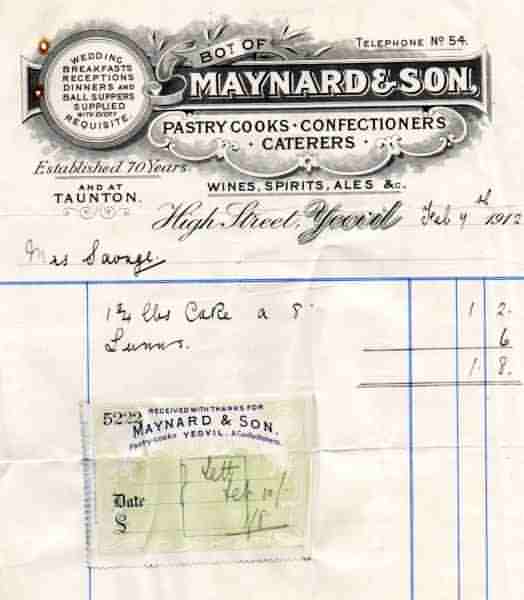
From my
collection
A receipt of 1912, showing the magnificent Maynard & Son letterhead. Note the telephone number '54'.
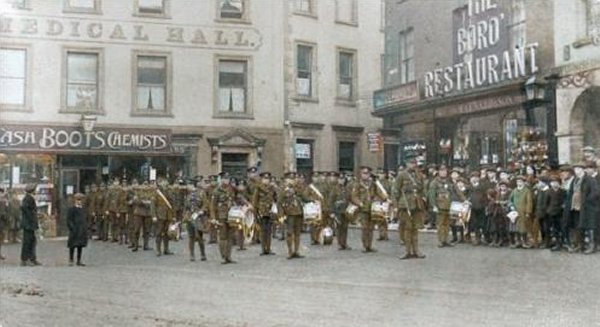
Troops parade in the Borough in 1914 (there's always one who has to turn around!). The Medical Hall at left and Maynard's Borough Restaurant at right flanking Wine Street.
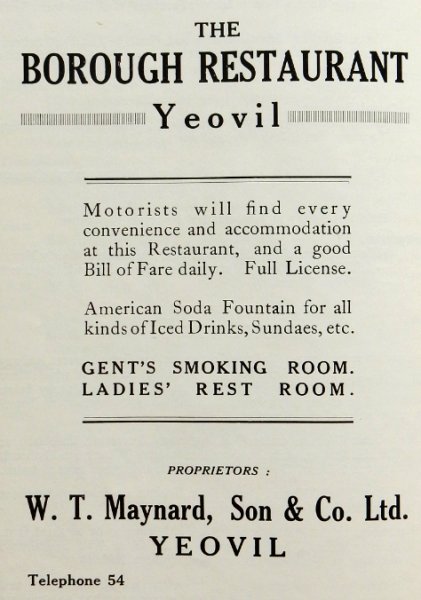
From my
collection
An advertisement for Maynard's Borough Restaurant in a Yeovil Guide of the late 1920s. Note the 'American Soda Fountain'.
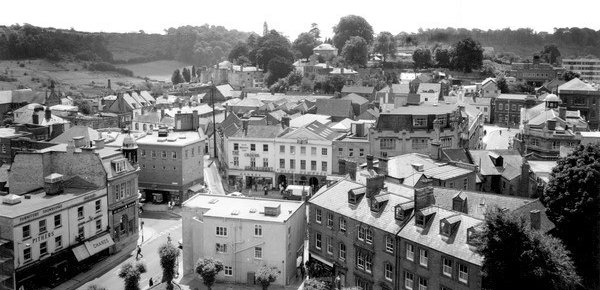
The Borough as seen from the top of St John's tower and photographed in the mid-1960s. At bottom left is the top of Silver Street, along the bottom is the eastern end of Church Street.
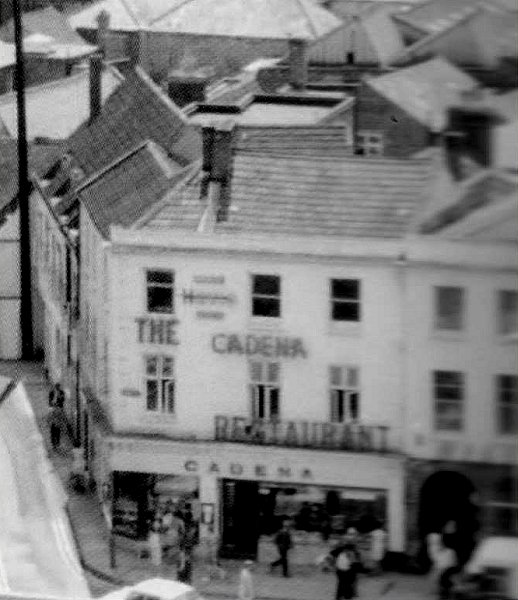
The Cadena Restaurant, photographed from the top of St John's church during the 1960s.
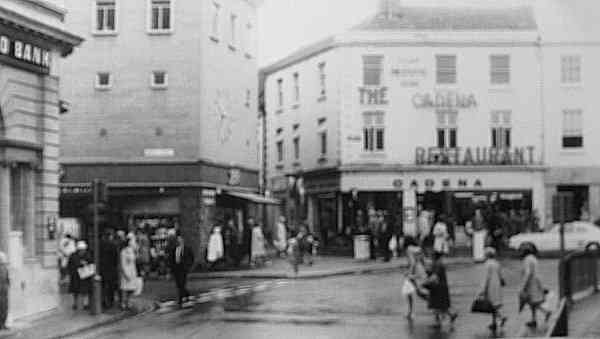
... and photographed from ground level in the 1970s.
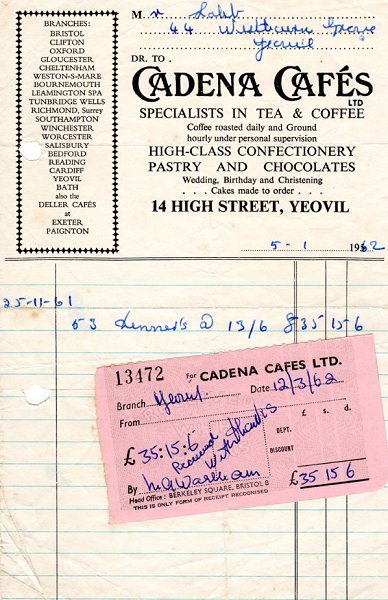
Courtesy of the
Old Yeovilians
Association Archive
A 1962 receipt for 53 dinners at the Cadena - and before you can say "Blimey, who eats 53 dinners?" it was for an Old Yeovilians Association reunion dinner.
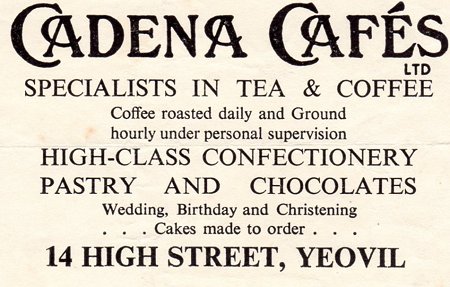
Courtesy of the
Old Yeovilians
Association Archive
.... and a Cadena advertisement from around the same period.
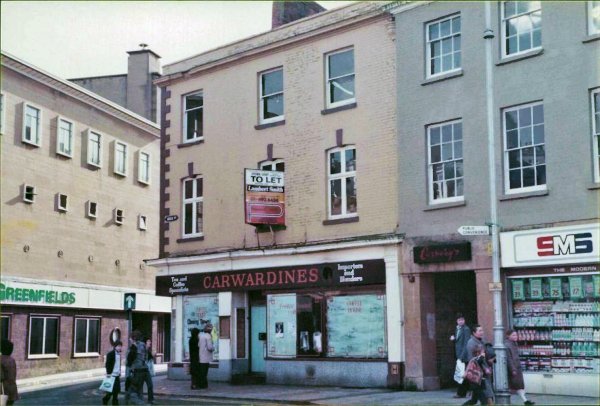
After the Cadena closed, the building became the premises of Carwardines, another "coffee specialist" shop. This photograph dates to late 1982, shortly before the building was demolished the following year.
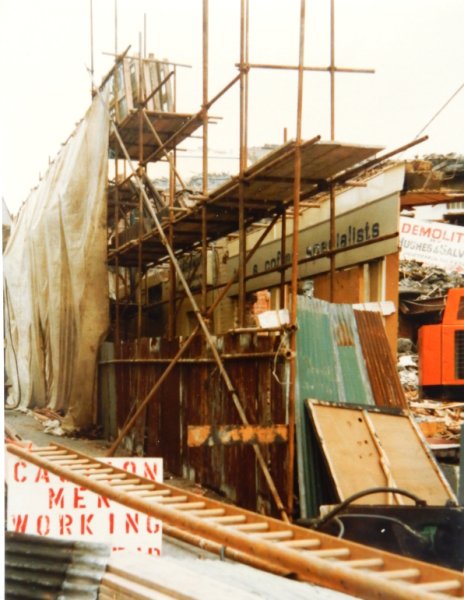
Courtesy of Rob
Baker
The Wine Street
side of the
Cadena
mid-demolition
in 1983.
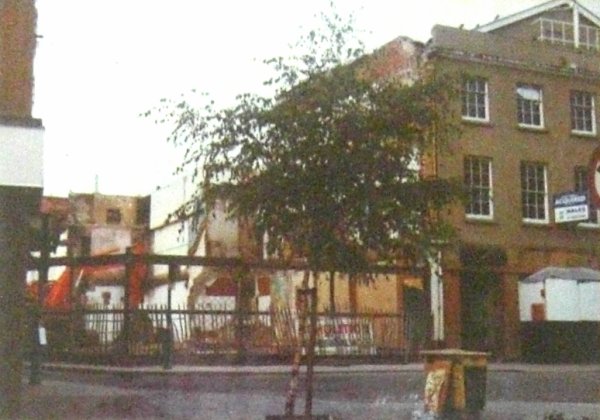
Courtesy of
Roger Froude
The demolition of the Cadena in 1983, photographed from the end of Middle Street.
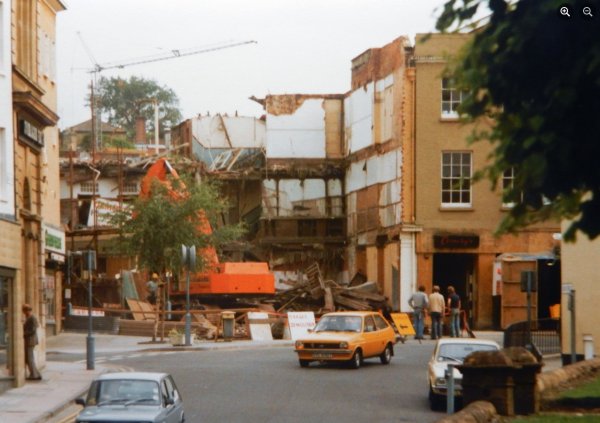
.... and seen from the Borough.
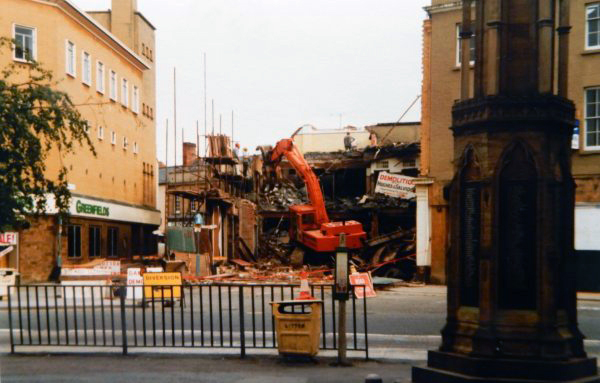
Courtesy of Rob
Baker
.... and seen from the Borough again but slightly later.